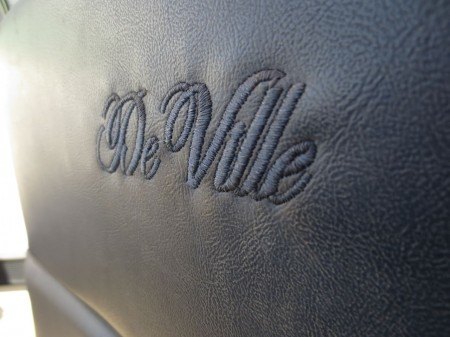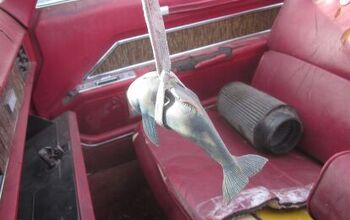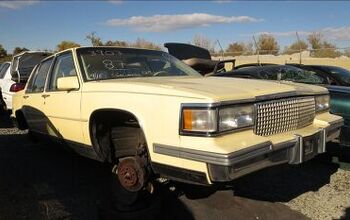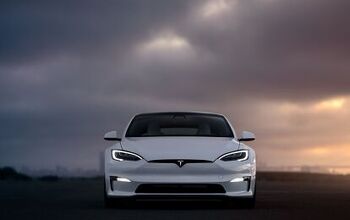Junkyard Find: 1988 Cadillac Coupe De Ville GT

By the late 1980s, the Coupe de Ville had become a not-so-imposing front-wheel-drive machine, sharing the C-body platform used by the Buick Park Avenue and Olds 98. GM had squeezed much of the remaining value out of the Cadillac name by that point, and the average age of the World War II vets who aspired to Cadillac ownership had crept up to close to 70. We don’t really notice these cars today, though quite a few are still on the road, but this one caught my eye because it is a very rare GT version.
As we can see in the 1988 ad above, GM was desperate to woo some younger buyers to the marque. As the 1980s ground on, conspicuous greed became increasingly fashionable, so the marketers imagined that successful American 30-somethings would drive to the polo championship in shiny new Coupe de Villes instead of those damn German cars. Hey, if they want something European, there’s always the Allanté!
These things weren’t bad to drive, but they just didn’t radiate luxury the way their predecessors did. It took Cadillac a long time to come back from the dark days of, say, 1972 until the Escalade Era.
I didn’t see any Landau emblems, but the padded vinyl landau roof is in full effect.
Cadillac never made a factory Coupe de Ville GT, of course; this one boasts some enhancements added by what I assume was its final owner.
The pinstripe decals on the marker lights were likely applied by the same owner.
The HT4100 V8 engine gets a bad rap, but the half-dozen or so we’ve seen in 24 Hours of LeMons racing have been very reliable. Perhaps the problem with this engine on the street is the lack of cornering G forces to massage the engine oil properly.
I may have to go back and buy these crypto-opera interior lights for my van.
170,125 miles on the clock, which was pretty good for a late-80s GM product.

Murilee Martin is the pen name of Phil Greden, a writer who has lived in Minnesota, California, Georgia and (now) Colorado. He has toiled at copywriting, technical writing, junkmail writing, fiction writing and now automotive writing. He has owned many terrible vehicles and some good ones. He spends a great deal of time in self-service junkyards. These days, he writes for publications including Autoweek, Autoblog, Hagerty, The Truth About Cars and Capital One.
More by Murilee Martin
Latest Car Reviews
Read moreLatest Product Reviews
Read moreRecent Comments
- MaintenanceCosts Nobody here seems to acknowledge that there are multiple use cases for cars.Some people spend all their time driving all over the country and need every mile and minute of time savings. ICE cars are better for them right now.Some people only drive locally and fly when they travel. For them, there's probably a range number that works, and they don't really need more. For the uses for which we use our EV, that would be around 150 miles. The other thing about a low range requirement is it can make 120V charging viable. If you don't drive more than an average of about 40 miles/day, you can probably get enough electrons through a wall outlet. We spent over two years charging our Bolt only through 120V, while our house was getting rebuilt, and never had an issue.Those are extremes. There are all sorts of use cases in between, which probably represent the majority of drivers. For some users, what's needed is more range. But I think for most users, what's needed is better charging. Retrofit apartment garages like Tim's with 240V outlets at every spot. Install more L3 chargers in supermarket parking lots and alongside gas stations. Make chargers that work like Tesla Superchargers as ubiquitous as gas stations, and EV charging will not be an issue for most users.
- MaintenanceCosts I don't have an opinion on whether any one plant unionizing is the right answer, but the employees sure need to have the right to organize. Unions or the credible threat of unionization are the only thing, history has proven, that can keep employers honest. Without it, we've seen over and over, the employers have complete power over the workers and feel free to exploit the workers however they see fit. (And don't tell me "oh, the workers can just leave" - in an oligopolistic industry, working conditions quickly converge, and there's not another employer right around the corner.)
- Kjhkjlhkjhkljh kljhjkhjklhkjh [h3]Wake me up when it is a 1989 635Csi with a M88/3[/h3]
- BrandX "I can charge using the 240V outlets, sure, but it’s slow."No it's not. That's what all home chargers use - 240V.
- Jalop1991 does the odometer represent itself in an analog fashion? Will the numbers roll slowly and stop wherever, or do they just blink to the next number like any old boring modern car?






















































Comments
Join the conversation
The 80s weren't a good time for Caddys. I love the early 80s Devilles, Broughams and Eldos but the engines were supposedly really unreliable. I think this generation Deville is one of the worst Caddys, as it looks like a slightly shorter version of a Park Avenue of the same vintage, which, due to some design elements, was a much easier car on the eyes. These Devilles look shortened and stubby because of GM's whole downsizing effort at the time. Same with 86 Eldorado restyling. At least the 98s and Electras of those years seemed proportional. Cadillac fixed it with the 89-93 Devilles though, as those are much nicer looking. Broughams will always be the best of that time period though.
I could see this Caddy getting a V-Series restomod treatment, perhaps something along the lines of what Jay Leno did to his 1966 Oldsmobile Toronado.